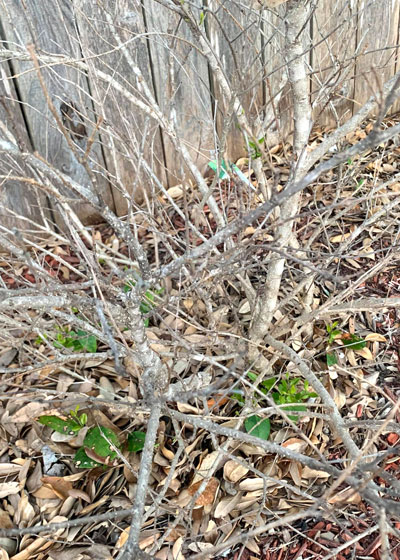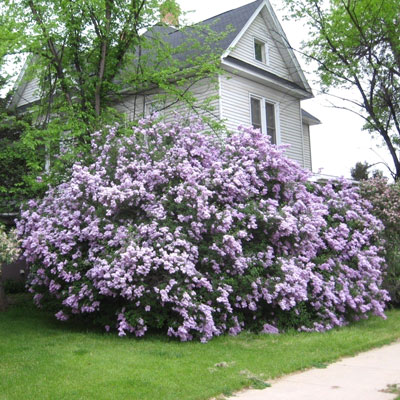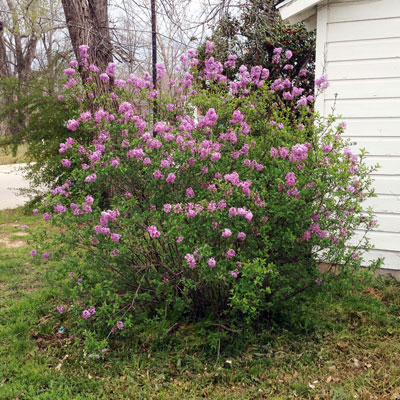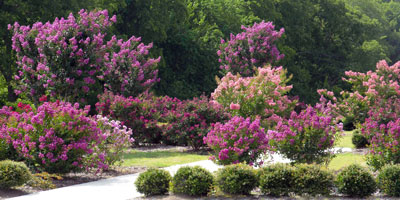What Do We Really Want?
There have been a couple of topics that have come up in the past week. I’ve been addressing one question probably 500 times per week since the big chill of February 16. The other I’ve been addressing on and off for the past 50 years.

“Neil, can this plant be saved?”
So, how do I answer this honestly? This is a photo that was posted to my Facebook page, and that’s the question that tagged along with it.
It’s a waxleaf ligustrum. It’s not unlike most waxleaf ligustrums in Texas this year, except that it does have a few green leaves on new sprouts. So, technically I guess this plant could be saved.
But does this plant really justify it? How long will it take for it to recover and get back to its former beauty? Will the homeowner be willing to wait for the several years it’s going to take?
I know that I wouldn’t. Waxleaf ligustrums don’t regrow that quickly, plus I’d still have a waxleaf ligustrum that could face the same fate again in another cold winter. (I live in North Texas, as does this gardener.)
I do understand that many folks are strapped for cash right now, and I do know that some plants come back from their roots with great vigor when frozen (examples, crape myrtles and oleanders).
But waxleaf ligustrums do not. I’d rather take plants like this out and replace them with something else that could be getting established, even if it meant that I had to start small. I’d rely on my Texas Certified Nursery Professional to show me the best plants for my area.
That’s what I’d do, and that’s why I warned you this would be my opinion.
“Neil… Why don’t you encourage people more to grow lilacs? I’ve had one for years and it blooms every spring in my Texas landscape.”
For 50 years I’ve been having these discussions. For 50 years wholesale growers have been claiming that they finally had a lilac that could stand up to Texas conditions. For 50 years I’ve been saying the same things…
Folks are certainly welcome to grow lilacs in Texas. My goal is not to discourage anyone. My responsibility, as I see it, is just to point out any pitfalls, and lilacs don’t like Texas weather. We’re just too hot to suit them, summer and winter.

That’s why they do so well in the Upper Midwest. Places like Wisconsin and Minnesota, Ohio (where I met them while getting two degrees at Ohio State), Indiana and Illinois. And they’re glorious in the Pacific Northwest.

When I worked at the Texas A&M Center in Far North Dallas from 1972 through 1977 there was a lilac growing outside our building. The old-time veterans of the Texas Research Foundation (prior to TAMU taking it over) told me it had been planted back in the 1940s. They said it had been 4 feet tall at that time. I noted that it was 3 feet tall while were standing alongside it in 1972. They just smiled.
Flower heads on lilacs in the Midwest are the size of shoeboxes. In Texas they’re more the size of tennis balls. And often sparsely set on the plants. Fragrant? Yes. But dazzling? Not so much.

So, do I have a better solution? Perhaps. Lavender and purple crape myrtles may not smell like lilacs, but their floral display is just as showy, and it lasts much longer. I’ll put Catawba and Velma’s Royal Delight crape myrtles (my two personal favorites) up against lilacs any day of the week for Texas landscaping.
That’s why I say what I do about lilacs. It’s not to discourage anyone. Quite the opposite. It’s to encourage success. If you’re in the I-20 corridor, try one lilac, but control your expectations. You’re in Texas now, and we do have some superior plants of our own.

Note: And what about Vitex, the plant that’s also called “Texas lilac?” It’s a great shrub, but honestly, I can’t explain any part of its name. It doesn’t look or smell like a lilac. It’s native from the Mediterranean to Pakistan, not Texas.
Its other common name is “lilac chaste-tree.” Southern Living says that that dates back to Medieval times when it was thought that some kind of extract from the fruit would, well… you get the picture. Who comes up with this stuff?
I’ll just call it “Vitex” and I’ll use it as another nice shrub with blue flowers.
